Religion Baptist | Name John Rockefeller Role Business magnate | |
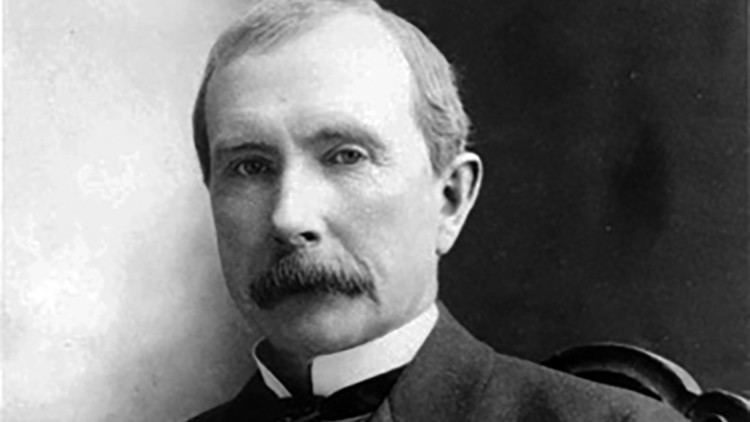 | ||
Full Name John Davison Rockefeller Resting place Lake View Cemetery, Cleveland, Ohio41°30′40″N 81°35′28″W / 41.511°N 81.591°W / 41.511; -81.591 Occupation Founder and former chairman of the Standard Oil Company, Founder of the University of Chicago and Rockefeller University, Funded the establishment of Central Philippine University, Founder of the General Education Board, Founder of the Rockefeller Foundation Net worth US$336 billion in 2007 dollars, according to List of wealthiest historical figures, based on information from Forbes – September 2007 Parent(s) William Avery Rockefeller Sr., Eliza Davison Children John D. Rockefeller, Jr., Edith Rockefeller McCormick Similar People Andrew Carnegie, David Rockefeller, J P Morgan, John D Rockefeller - Jr, Cornelius Vanderbilt | ||
John d rockefeller reads a newspaper and plays golf hd stock footage
John Davison Rockefeller Sr. (July 8, 1839 – May 23, 1937) was an American oil industry business magnate and philanthropist. Widely considered the wealthiest American of all time and the richest person in modern history, Rockefeller was born into a large family in upstate New York and was shaped by his con man father and religious mother. His family moved several times before eventually settling in Cleveland, Ohio.
Contents
- John d rockefeller reads a newspaper and plays golf hd stock footage
- John D Rockefellers Advice for Young People Who Want to Be Rich
- Early life
- As a bookkeeper
- Business partnership and Civil War service
- Beginning in the oil business
- Founding and early growth
- Monopoly
- Colorado Fuel and Iron
- Strike of 191314 and the Ludlow Massacre
- Illnesses and death
- Family
- Marriage
- Religious views
- Rumors
- Philanthropy
- Florida home
- Legacy
- References
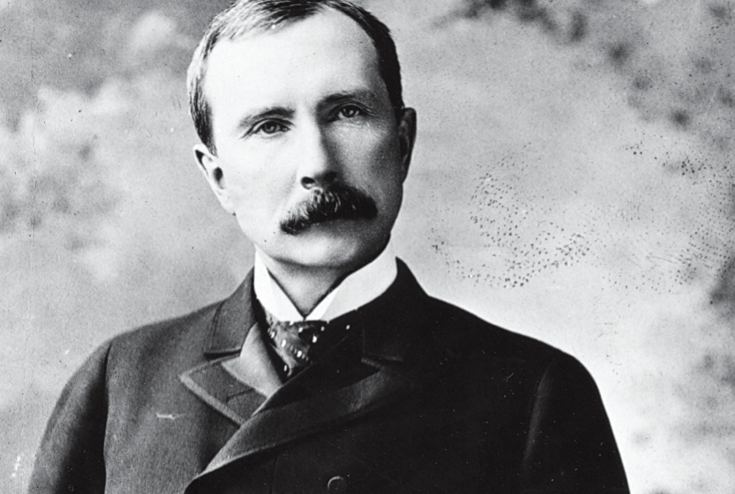
Rockefeller became an assistant bookkeeper at the age of 16, and went into a business partnership with Maurice B. Clark and his brothers at 20. After buying them out, he and his brother William founded Rockefeller & Andrews with Samuel Andrews. Instead of drilling for oil, he concentrated on refining. In 1867, Henry Flagler entered the partnership. The Rockefeller, Andrews & Flagler company grew by incorporating local refineries. Rockefeller formally founded the Standard Oil Company, Inc. in 1870 as an Ohio partnership with his brother, Henry Flagler, Jabez A. Bostwick, Samuel Andrews and a silent partner, Stephen V. Harkness. He ran it until 1897.
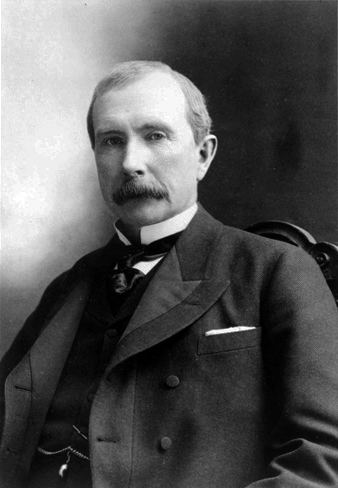
As kerosene and gasoline grew in importance, Rockefeller's wealth soared and he became the richest person in the country, controlling 90% of all oil in the United States at his peak. Oil was used throughout the country as a light source until the introduction of electricity and as a fuel after the invention of the automobile. Furthermore, Rockefeller gained enormous influence over the railroad industry, which transported his oil around the country. Standard Oil was the first great business trust in the United States. Rockefeller revolutionized the petroleum industry, and along with other key contemporary industrialists such as steel magnate Andrew Carnegie, defined the structure of modern philanthropy.
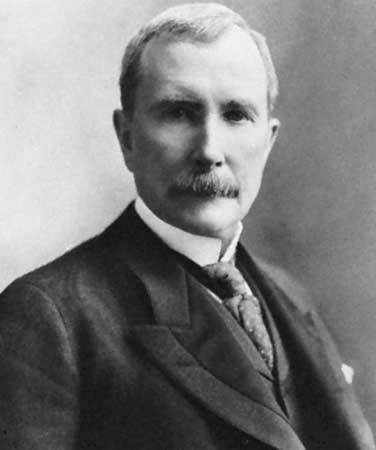
The U.S. Supreme Court ruled in 1911 that Standard Oil must be dismantled for violation of federal anti-trust laws. It was broken up into 34 separate entities that included companies that would become ExxonMobil, Chevron and others. Some of them still having the largest revenue, as individual pieces of the company were worth more than the whole and, as shares of these doubled and tripled in value in their early years, Rockefeller became the country's first billionaire with a fortune worth nearly 2 percent of the national economy. His peak net worth was estimated at $336 billion (in 2007 USD, inflation-adjusted) in 1913. Rockefeller spent the last 40 years of his life in retirement at his estate in Westchester County, New York. His fortune was mainly used to create the modern systematic approach of targeted philanthropy through the creation of foundations that had a major effect on medicine, education and scientific research. His foundations pioneered the development of medical research and were instrumental in the eradication of hookworm and yellow fever.
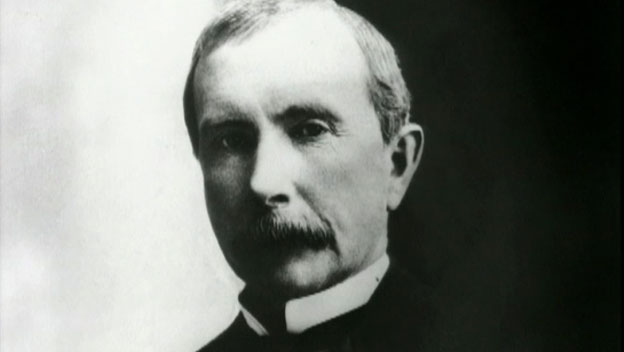
Rockefeller was also the founder of both the University of Chicago and Rockefeller University and funded the establishment of Central Philippine University in the Philippines. He was a devout Northern Baptist and supported many church-based institutions. Rockefeller adhered to total abstinence from alcohol and tobacco throughout his life. He was a faithful congregant of the Erie Street Baptist Mission Church, where he taught Sunday school, and served as a trustee, clerk and occasional janitor. Religion was a guiding force throughout his life and Rockefeller believed it to be the source of his success. Rockefeller was also considered a supporter of capitalism based on a perspective of social Darwinism and was quoted often as saying: "The growth of a large business is merely a survival of the fittest".

John D Rockefeller's Advice for Young People Who Want to Be Rich
Early life
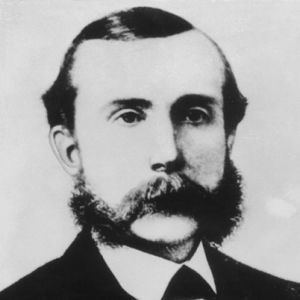
Rockefeller was the second of six children and eldest son born in Richford, New York to con artist William Avery "Bill" Rockefeller (November 13, 1810 – May 11, 1906) and Eliza Davison (September 12, 1813 – March 28, 1889). His siblings were Lucy (1838–1878), William Jr. (1841–1922), Mary (1843–1925) and twins Franklin (Frank) (1845–1917) and Frances (1845–1847). His father was of English and German descent while his mother was of Scots-Irish descent. Bill was first a lumberman and then a traveling salesman who identified himself as a "botanic physician" and sold elixirs. The locals referred to the mysterious but fun-loving man as "Big Bill" and "Devil Bill". He was a sworn foe of conventional morality who had opted for a vagabond existence and who returned to his family infrequently. Throughout his life, Bill was notorious for shady schemes. In between the births of Lucy and John, Bill and his mistress/housekeeper Nancy Brown had a daughter named Clorinda who died young. Between John and William Jr.'s births, Bill and Nancy had another daughter, Cornelia.
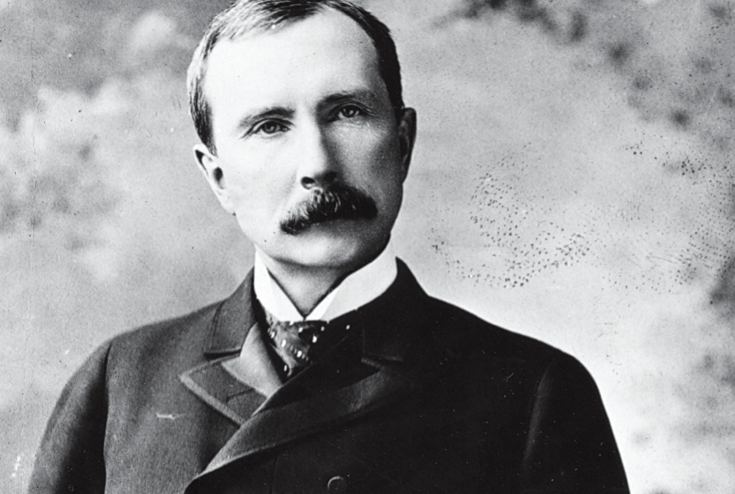
Eliza, a homemaker and a devout Baptist, struggled to maintain a semblance of stability at home, as Bill was frequently gone for extended periods. She also put up with his philandering and his double life, which included bigamy. Thrifty by nature and necessity, she taught her son that "willful waste makes woeful want". John did his share of the regular household chores and earned extra money raising turkeys, selling potatoes and candy, and eventually lending small sums of money to neighbors. He followed his father's advice to "trade dishes for platters" and always get the better part of any deal. Bill once bragged, "I cheat my boys every chance I get. I want to make 'em sharp."
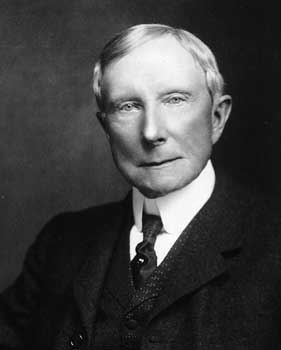
When he was a boy, his family moved to Moravia, New York, and in 1851 to Owego, New York, where he attended Owego Academy. In 1853, his family moved to Strongsville, Ohio and he attended Cleveland's Central High School, the first high school in Cleveland and the first free, public high school west of the Alleghenies. Then, he took a ten-week business course at Folsom's Commercial College, where he studied bookkeeping. Despite his father's absences and frequent family moves, young John was a well-behaved, serious, and studious boy. His contemporaries described him as reserved, earnest, religious, methodical, and discreet. He was an excellent debater and expressed himself precisely. He also had a deep love of music and dreamed of it as a possible career.
As a bookkeeper
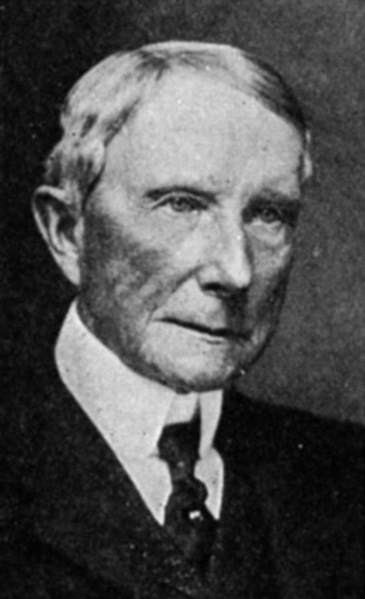
In September 1855, when Rockefeller was sixteen, he got his first job as an assistant bookkeeper working for a small produce commission firm called Hewitt & Tuttle. He worked long hours and delighted, as he later recalled, in "all the methods and systems of the office." He was particularly adept at calculating transportation costs, which served him well later in his career. Making 50 cents a day, the full salary for his first three months' work was $50 (equivalent to $1 thousand in 2016 dollars).
As a youth, Rockefeller reportedly said that his two great ambitions were to make $100,000 (equivalent to $3 million in 2016 dollars) and to live 100 years.
Business partnership and Civil War service
In 1859, Rockefeller went into the produce commission business with a partner, Maurice B. Clark, and they raised $4,000 ($106,622 in 2016 dollars) in capital. Rockefeller went steadily ahead in business from there, making money each year of his career. While his brother Frank fought in the Civil War, Rockefeller tended his business and hired substitute soldiers. He gave money to the Union cause, as did many rich Northerners who avoided combat. Rockefeller was an abolitionist who voted for President Abraham Lincoln and supported the then-new Republican Party. As he said, "God gave me money", and he did not apologize for it. He felt at ease and righteous following Methodist preacher John Wesley's dictum, "gain all you can, save all you can, and give all you can."
At that time, the Federal government was subsidizing oil prices, driving the price up from $.35 a barrel in 1862 to as high as $13.75. This created an oil-drilling glut, with thousands of speculators attempting to make their fortunes. Most failed, but those who struck oil did not even need to be efficient. They would blow holes in the ground and gather up the oil as they could, often leading to creeks and rivers flowing with wasted oil in the place of water.
In this environment of wasteful boom, the partners switched from foodstuffs to oil, building an oil refinery in 1863 in "The Flats", then Cleveland's burgeoning industrial area. The refinery was directly owned by Andrews, Clark & Company, which was composed of Clark & Rockefeller, chemist Samuel Andrews, and M. B. Clark's two brothers. The commercial oil business was then in its infancy. Whale oil had become too expensive for the masses, and a cheaper, general-purpose lighting fuel was needed.
While other refineries would keep the 60% of oil product that became kerosene, but dump the other 40% in rivers and massive sludge piles, Rockefeller remained as thrifty and efficient as ever, using the gasoline to fuel the refinery, and selling the rest as lubricating oil, petroleum jelly and paraffin wax, and other by-products. Tar was used for paving, naphtha shipped to gas plants. Likewise, Rockefeller's refineries hired their own plumbers, cutting the cost of pipe-laying in half. Barrels that cost $2.50 each ended up only $.96 when Rockefeller bought the wood and had them built for himself.
In February 1865, in what was later described by oil industry historian Daniel Yergin as a "critical" action, Rockefeller bought out the Clark brothers for $72,500 (equivalent to $1 million in 2016 dollars) at auction and established the firm of Rockefeller & Andrews. Rockefeller said, "It was the day that determined my career." He was well positioned to take advantage of postwar prosperity and the great expansion westward fostered by the growth of railroads and an oil-fueled economy. He borrowed heavily, reinvested profits, adapted rapidly to changing markets, and fielded observers to track the quickly expanding industry.
Beginning in the oil business
In 1866, William Rockefeller Jr., John's brother, built another refinery in Cleveland and brought John into the partnership. In 1867, Henry M. Flagler became a partner, and the firm of Rockefeller, Andrews & Flagler was established. By 1868, with Rockefeller continuing practices of borrowing and reinvesting profits, controlling costs, and using refineries' waste, the company owned two Cleveland refineries and a marketing subsidiary in New York; it was the largest oil refinery in the world. Rockefeller, Andrews & Flagler was the predecessor of the Standard Oil Company.
Founding and early growth
By the end of the American Civil War, Cleveland was one of the five main refining centers in the U.S. (besides Pittsburgh, Pennsylvania, New York, and the region in northwestern Pennsylvania where most of the oil originated). By 1869 there was three times more kerosene refining capacity than needed to supply the market, and the capacity remained in excess for many years.
On 10 January 1870, Rockefeller abolished the partnership of Rockefeller, Andrews & Flagler, forming Standard Oil of Ohio. Continuing to apply his work ethic and efficiency, Rockefeller quickly expanded the company to be the most profitable refiner in Ohio. Likewise, it became one of the largest shippers of oil and kerosene in the country. The railroads competed fiercely for traffic and, in an attempt to create a cartel to control freight rates, formed the South Improvement Company offering special deals to bulk customers like Standard Oil, outside the main oil centers. The cartel offered preferential treatment as a high-volume shipper, which included not just steep discounts/rebates of up to 50% for their product but rebates for the shipment of competing products.
Part of this scheme was the announcement of sharply increased freight charges. This touched off a firestorm of protest from independent oil well owners, including boycotts and vandalism, which led to the discovery of Standard Oil's part in the deal. A major New York refiner, Charles Pratt and Company, headed by Charles Pratt and Henry H. Rogers, led the opposition to this plan, and railroads soon backed off. Pennsylvania revoked the cartel's charter, and non-preferential rates were restored for the time being. While competitors may have been unhappy, Rockefeller's efforts did bring American consumers cheaper kerosene and other oil by-products. Before 1870, oil light was only for the wealthy, provided by expensive whale oil. But during the next decade, kerosene became commonly available to the working and middle classes.
Undeterred, though vilified for the first time by the press, Rockefeller continued with his self-reinforcing cycle of buying the least efficient competing refiners, improving the efficiency of his operations, pressing for discounts on oil shipments, undercutting his competition, making secret deals, raising investment pools, and buying rivals out. In less than four months in 1872, in what was later known as "The Cleveland Conquest" or "The Cleveland Massacre", Standard Oil absorbed 22 of its 26 Cleveland competitors. Eventually, even his former antagonists, Pratt and Rogers, saw the futility of continuing to compete against Standard Oil: in 1874, they made a secret agreement with Rockefeller to be acquired.
Pratt and Rogers became Rockefeller's partners. Rogers, in particular, became one of Rockefeller's key men in the formation of the Standard Oil Trust. Pratt's son, Charles Millard Pratt, became Secretary of Standard Oil. For many of his competitors, Rockefeller had merely to show them his books so they could see what they were up against and make them a decent offer. If they refused his offer, he told them he would run them into bankruptcy and then cheaply buy up their assets at auction. But this was not intended to eliminate competition entirely. In fact, his partner Pratt said of that accusation "Competitors we must have...if we absorb them, it surely will bring up another."
Instead of wanting to eliminate them, Rockefeller saw himself as the industry's savior, "an angel of mercy" absorbing the weak and making the industry as a whole stronger, more efficient, and more competitive. Standard was growing horizontally and vertically. It added its own pipelines, tank cars, and home delivery network. It kept oil prices low to stave off competitors, made its products affordable to the average household, and, to increase market penetration, sometimes sold below cost. It developed over 300 oil-based products from tar to paint to petroleum jelly to chewing gum. By the end of the 1870s, Standard was refining over 90% of the oil in the U.S. Rockefeller had already become a millionaire ($1 million is equivalent to $25 million in 2016 dollars).
"He instinctively realized that orderliness would only proceed from centralized control of large aggregations of plant and capital, with the one aim of an orderly flow of products from the producer to the consumer. That orderly, economic, efficient flow is what we now, many years later, call 'vertical integration' I do not know whether Mr. Rockefeller ever used the word 'integration'. I only know he conceived the idea." A Standard Oil of Ohio successor of Rockefeller
In 1877, Standard clashed with Thomas A. Scott, the president of the Pennsylvania Railroad, Standard's chief hauler. Rockefeller envisioned pipelines as an alternative transport system for oil and began a campaign to build and acquire them. The railroad, seeing Standard's incursion into the transportation and pipeline fields, struck back and formed a subsidiary to buy and build oil refineries and pipelines.
Standard countered and held back its shipments and, with the help of other railroads, started a price war that dramatically reduced freight payments and caused labor unrest. Rockefeller prevailed and the railroad sold its oil interests to Standard. But in the aftermath of that battle, in 1879 the Commonwealth of Pennsylvania indicted Rockefeller on charges of monopolizing the oil trade, starting an avalanche of similar court proceedings in other states and making a national issue of Standard Oil's business practices. Rockefeller was under great strain during the 1870s and 1880s when he was carrying out his plan of consolidation and integration and being attacked by the press. He complained that he could not stay asleep most nights. Rockefeller later commented:
"All the fortune that I have made has not served to compensate me for the anxiety of that period."
Monopoly
Although it always had hundreds of competitors, Standard Oil gradually gained dominance of oil refining and sales as market share in the United States through horizontal integration, ending up with about 90% of the US market. In the kerosene industry, the company replaced the old distribution system with its own vertical system. It supplied kerosene by tank cars that brought the fuel to local markets, and tank wagons then delivered to retail customers, thus bypassing the existing network of wholesale jobbers. Despite improving the quality and availability of kerosene products while greatly reducing their cost to the public (the price of kerosene dropped by nearly 80% over the life of the company), Standard Oil's business practices created intense controversy. Standard's most potent weapons against competitors were underselling, differential pricing, and secret transportation rebates.
The firm was attacked by journalists and politicians throughout its existence, in part for these monopolistic methods, giving momentum to the antitrust movement. By 1880, according to the New York World, Standard Oil was "the most cruel, impudent, pitiless, and grasping monopoly that ever fastened upon a country". To critics Rockefeller replied, "In a business so large as ours ... some things are likely to be done which we cannot approve. We correct them as soon as they come to our knowledge."
At that time, many legislatures had made it difficult to incorporate in one state and operate in another. As a result, Rockefeller and his associates owned dozens of separate corporations, each of which operated in just one state; the management of the whole enterprise was rather unwieldy. In 1882, Rockefeller's lawyers created an innovative form of corporation to centralize their holdings, giving birth to the Standard Oil Trust. The "trust" was a corporation of corporations, and the entity's size and wealth drew much attention. Nine trustees, including Rockefeller, ran the 41 companies in the trust. The public and the press were immediately suspicious of this new legal entity, and other businesses seized upon the idea and emulated it, further inflaming public sentiment. Standard Oil had gained an aura of invincibility, always prevailing against competitors, critics, and political enemies. It had become the richest, biggest, most feared business in the world, seemingly immune to the boom and bust of the business cycle, consistently making profits year after year.
The company's vast American empire included 20,000 domestic wells, 4,000 miles of pipeline, 5,000 tank cars, and over 100,000 employees. Its share of world oil refining topped out above 90% but slowly dropped to about 80% for the rest of the century. Despite the formation of the trust and its perceived immunity from all competition, by the 1880s Standard Oil had passed its peak of power over the world oil market. Rockefeller finally gave up his dream of controlling all the world's oil refining, he admitted later, "We realized that public sentiment would be against us if we actually refined all the oil." Over time foreign competition and new finds abroad eroded his dominance. In the early 1880s, Rockefeller created one of his most important innovations. Rather than try to influence the price of crude oil directly, Standard Oil had been exercising indirect control by altering oil storage charges to suit market conditions. Rockefeller then ordered the issuance of certificates against oil stored in its pipelines. These certificates became traded by speculators, thus creating the first oil-futures market which effectively set spot market prices from then on. The National Petroleum Exchange opened in Manhattan in late 1882 to facilitate the trading of oil futures.
Although 85% of world crude production was still coming from Pennsylvania wells in the 1880s, drilling in Russia and Asia began to reach the world market. Robert Nobel had established his own refining enterprise in the abundant and cheaper Russian oil fields, including the region's first pipeline and the world's first oil tanker. The Paris Rothschilds jumped into the fray providing financing. Additional fields were discovered in Burma and Java. Even more critical, the invention of the light bulb gradually began to erode the dominance of kerosene for illumination. But Standard Oil adapted, developing a European presence, expanding into natural gas production in the U.S. then into gasoline for automobiles, which until then had been considered a waste product.
Standard Oil moved its headquarters to New York City at 26 Broadway, and Rockefeller became a central figure in the city's business community. He bought a residence in 1884 on 54th Street near the mansions of other magnates such as William Henry Vanderbilt. Despite personal threats and constant pleas for charity, Rockefeller took the new elevated train to his downtown office daily. In 1887, Congress created the Interstate Commerce Commission which was tasked with enforcing equal rates for all railroad freight, but by then Standard depended more on pipeline transport. More threatening to Standard's power was the Sherman Antitrust Act of 1890, originally used to control unions, but later central to the breakup of the Standard Oil trust. Ohio was especially vigorous in applying its state anti-trust laws, and finally forced a separation of Standard Oil of Ohio from the rest of the company in 1892, the first step in the dissolution of the trust.
In the 1890s, Rockefeller expanded into iron ore and ore transportation, forcing a collision with steel magnate Andrew Carnegie, and their competition became a major subject of the newspapers and cartoonists. He went on a massive buying spree acquiring leases for crude oil production in Ohio, Indiana, and West Virginia, as the original Pennsylvania oil fields began to play out. Amid the frenetic expansion, Rockefeller began to think of retirement. The daily management of the trust was turned over to John Dustin Archbold and Rockefeller bought a new estate, Pocantico Hills, north of New York City, turning more time to leisure activities including the new sports of bicycling and golf.
Upon his ascent to the presidency, Theodore Roosevelt initiated dozens of suits under the Sherman Antitrust Act and coaxed reforms out of Congress. In 1901, U.S. Steel, then controlled by J. Pierpont Morgan, having bought Andrew Carnegie's steel assets, offered to buy Standard's iron interests as well. A deal brokered by Henry Clay Frick exchanged Standard's iron interests for U.S. Steel stock and gave Rockefeller and his son membership on the company’s board of directors. In full retirement at age 63, Rockefeller earned over $58 million in investments in 1902.
One of the most effective attacks on Rockefeller and his firm was the 1904 publication of The History of the Standard Oil Company, by Ida Tarbell, a leading muckraker. She documented the company's espionage, price wars, heavy-handed marketing tactics, and courtroom evasions. Although her work prompted a huge backlash against the company, Tarbell stated she was surprised at its magnitude. "I never had an animus against their size and wealth, never objected to their corporate form. I was willing that they should combine and grow as big and wealthy as they could, but only by legitimate means. But they had never played fair, and that ruined their greatness for me." Tarbell's father had been driven out of the oil business during the "South Improvement Company" affair. Rockefeller called her "Miss Tarbarrel" in private but held back in public saying only, "not a word about that misguided woman." He began a publicity campaign to put his company and himself in a better light. Though he had long maintained a policy of active silence with the press, he decided to make himself more accessible and responded with conciliatory comments such as "capital and labor are both wild forces which require intelligent legislation to hold them in restriction." He wrote and published his memoirs beginning in 1908. Critics found his writing to be sanitized and disingenuous and thought that statements such as "the underlying, essential element of success in business is to follow the established laws of high-class dealing" seemed to be at odds with his true business methods.
Rockefeller and his son continued to consolidate their oil interests as best they could until New Jersey, in 1909, changed its incorporation laws to effectively allow a re-creation of the trust in the form of a single holding company. Rockefeller retained his nominal title as president until 1911 and he kept his stock. At last in 1911, the Supreme Court of the United States found Standard Oil Company of New Jersey in violation of the Sherman Antitrust Act. By then the trust still had a 70% market share of the refined oil market but only 14% of the U.S. crude oil supply. The court ruled that the trust originated in illegal monopoly practices and ordered it to be broken up into 34 new companies. These included, among many others, Continental Oil, which became Conoco, now part of ConocoPhillips; Standard of Indiana, which became Amoco, now part of BP; Standard of California, which became Chevron; Standard of New Jersey, which became Esso (and later, Exxon), now part of ExxonMobil; Standard of New York, which became Mobil, now part of ExxonMobil; and Standard of Ohio, which became Sohio, now part of BP. Pennzoil and Chevron have remained separate companies.
Rockefeller, who had rarely sold shares, held over 25% of Standard's stock at the time of the breakup. He and all of the other stockholders received proportionate shares in each of the 34 companies. In the aftermath, Rockefeller's control over the oil industry was somewhat reduced but over the next 10 years, the breakup also proved immensely profitable for him. The companies' combined net worth rose fivefold and Rockefeller’s personal wealth jumped to $900 million.
Colorado Fuel and Iron
In 1902, facing cash flow problems, John Cleveland Osgood turned to George Jay Gould, a principal stockholder of the Denver and Rio Grande, for a loan. Gould, via Frederick Taylor Gates, Rockefeller's financial adviser, brought John D. Rockefeller in to help finance the loan. Analysis of the company's operations by John D. Rockefeller, Jr. showed a need for substantially more funds which were provided in exchange for acquisition of CF&I's subsidiaries such as the Colorado and Wyoming Railway Company, the Crystal River Railroad Company, and possibly the Rocky Mountain Coal and Iron Company. Control was passed from the Iowa Group to Gould and Rockefeller interests in 1903 with Gould in control and Rockefeller and Gates representing a minority interests. Osgood left the company in 1904 and devoted his efforts to operating competing coal and coke operations.
Strike of 1913–14 and the Ludlow Massacre
The strike, called in September 1913 by the United Mine Workers, over the issue of union representation, was against coal mine operators in Huerfano and Las Animas counties of southern Colorado, where the majority of CF&I's coal and coke production was located. The strike was fought vigorously by the coal mine operators association and its steering committee, which included Welborn, president of CF&I, a spokesman for the coal operators. Rockefeller's operative, Lamont Montgomery Bowers, remained in the background. Few miners actually belonged to the union or participated in the strike call, but the majority honored it. Strikebreakers (called "scabs") were threatened and sometimes attacked. Both sides purchased substantial arms and ammunition. Striking miners were forced to abandon their homes in company towns and lived in tent cities erected by the union, such as the tent city at Ludlow, a railway stop north of Trinidad.
Under the protection of the National Guard, some miners returned to work and some strikebreakers, imported from the eastern coalfields, joined them as Guard troops protecting their movements. In February 1914, a substantial portion of the troops were withdrawn, but a large contingent remained at Ludlow. On April 20, 1914, a general fire-fight occurred between strikers and troops, which was antagonized by the troops and mine guards. The camp was burned, resulting in 15 women and children, who hid in tents at the camp, being burned to death. Costs to both mine operators and the union were high. This incident brought unwanted national attention to Colorado.
Due to reduced demand for coal, resulting from an economic downturn, many of CF&I's coal mines never reopened and many men were thrown out of work. The union was forced to discontinue strike benefits in February 1915. There was destitution in the coal fields. With the help of funds from the Rockefeller Foundation, relief programs were organized by the Colorado Committee on Unemployment and Relief. A state agency created by Governor Carlson, offered work to unemployed miners building roads and doing other useful projects.
The casualties suffered at Ludlow were successfully labeled a massacre and mobilized public opinion against the Rockefellers and the coal industry. The United States Commission on Industrial Relations conducted extensive hearings, singling out John D. Rockefeller Jr. and the Rockefellers' relationship with Bowers for special attention. Bowers was relieved of duty and Wellborn restored to control in 1915, then industrial relations improved. Rockefeller denied any responsibility and minimized the seriousness of the event. When testifying on the Ludlow Massacre, and asked what action he would have taken as Director, John D. Rockefeller stated, "I would have taken no action. I would have deplored the necessity which compelled the officers of the company to resort to such measures to supplement the State forces to maintain law and order." Rockefeller admitted that he had made no attempt to bring the militiamen to justice.
Illnesses and death
In his 50s Rockefeller suffered from moderate depression and digestive troubles; during a stressful period in the 1890s he developed alopecia, the loss of some or all body hair.
By 1901 he began wearing toupées. His hair never grew back, but other health complaints subsided as he lightened his workload.
Rockefeller died of arteriosclerosis on May 23, 1937, less than two months shy of his 98th birthday, at "The Casements", his home in Ormond Beach, Florida. He was buried in Lake View Cemetery in Cleveland.
Family
Against long-circulating speculations that his family has French roots, genealogists proved the German origin of Rockefeller and traced them back to the early 17th century. Thereupon Johann Peter Rockenfeller (baptized 27 September 1682 in the Protestant church of Rengsdorf) immigrated in 1723 from Altwied (today a district of Neuwied, Rhineland-Palatinate) with three children to North America and settled down in Germantown, Pennsylvania.
The name Rockenfeller (from Rockenfeld) refers to Rockenfeld in the district of Neuwied.
Marriage
In 1864, Rockefeller married Laura Celestia "Cettie" Spelman (1839–1915), daughter of Harvey Buell Spelman and Lucy Henry. They had four daughters and one son together. He said later, "Her judgment was always better than mine. Without her keen advice, I would be a poor man."
The Rockefeller wealth, distributed as it was through a system of foundations and trusts, continued to fund family philanthropic, commercial, and, eventually, political aspirations throughout the 20th century. John Jr.'s youngest son David Rockefeller was a leading New York banker, serving for over 20 years as CEO of Chase Manhattan (now part of JPMorgan Chase). Second son, Nelson Aldrich Rockefeller, was Republican governor of New York and the 41st Vice President of the United States. Fourth son Winthrop Aldrich Rockefeller served as Republican Governor of Arkansas. Grandchildren Abigail Aldrich "Abby" Rockefeller and John Davison Rockefeller III became philanthropists. Grandson Laurance Spelman Rockefeller became a conservationist. Great-grandson John Davison "Jay" Rockefeller IV served from 1985 until 2015 as a Democratic Senator from West Virginia after serving as governor of West Virginia, and another, Winthrop, served as Lieutenant Governor of Arkansas for a decade.
Religious views
John D. Rockefeller was born in Richford, New York, then part of the Burned-over district — a New York state area being the site of an evangelical revival known as the Second Great Awakening; it drew masses to various Protestant churches—especially Baptist ones—urging believers to follow such ideals as hard work, prayer and good deeds to build "the Kingdom of God on Earth". Early in his life, he regularly went with his siblings and mother Eliza to the local Baptist church — the Erie Street Baptist Church (later the Euclid Avenue Baptist Church) — an independent Baptist church which eventually came to associate with the Northern Baptist Convention (1907-1950; modern American Baptist Churches USA).
His mother was deeply religious and disciplined, and had a major influence on him in religious matters. During church service, his mother would urge him to contribute his few pennies to the congregation. He came to associate the church with charity. A Baptist preacher once encouraged him to "make as much money as he could, and then give away as much as he could". Later in his life, Rockefeller recalled: "It was at this moment, that the financial plan of my life was formed". Money making was considered by him a God-given gift.
A devout Northern Baptist, Rockefeller would read the Bible daily, attend prayer meetings twice a week and even led his own Bible study with his wife. Burton Folsom Jr. has noted, he sometimes gave tens of thousands of dollars to Christian groups, while, at the same time, he was trying to borrow over a million dollar to expand his business. His philosophy of giving was founded upon biblical principles. He truly believed in the biblical principle found in Luke 6:38, "Give, and it will be given to you. A good measure, pressed down, shaken together and running over, will be poured into your lap. For with the measure you use, it will be measured to you."
Rockefeller would support Baptist missionary activity, fund universities, and heavily engage in religious activities at his Cleveland, Ohio church. While traveling the South, he would donate large sums of money to churches belonging to the Southern Baptist Convention, various Black churches, as well as other Christian denominations. One time, he paid for a slave's freedom and donated to a Roman Catholic orphanage. As he grew rich, his donations became more generous, especially to his church in Cleveland; nevertheless, it was demolished in 1925, and replaced with another building.
Rumors
At the height of Rockefeller's power as monopolist there began rumors that the family guards an "embarrassing secret". Joseph Pulitzer offered a reward of $8,000 for information about John's father, Bill, aka "Doc Rockefeller". However, journalists could not find him before his death, and only two years later the whole story was published.
Bill, who traveled as a mountebank across the country, sometimes a glad-handing huckster or occasionally as "herbal doctor", although he had no legitimate medical training, abandoned his family around 1855, but remained legally married to Eliza up to her death. He adopted the name William Levingston and married, as a bigamist in Norwich, Ontario, Margaret L. Allen (1834–1910), without issue. He died in 1906 and his tomb was paid from the property of his second wife.
Philanthropy
Rockefeller's charitable giving began with his first job as a clerk at age 16, when he gave six percent of his earnings to charity, as recorded in his personal ledger. By the time he was twenty, his charity exceeded ten percent of his income. Much of his giving was church-related. His church was later affiliated with the Northern Baptist Convention, which formed from American Baptists in the North with ties to their historic missions to establish schools and colleges for freedmen in the South after the American Civil War. Rockefeller attended Baptist churches every Sunday; when traveling he would often attend services at African-American Baptist congregations, leaving a substantial donation. As Rockefeller's wealth grew, so did his giving, primarily to educational and public health causes, but also for basic science and the arts. He was advised primarily by Frederick Taylor Gates after 1891, and, after 1897, also by his son.
He was allegedly influenced by a meeting in 1893 with Swami Vivekananda, who urged him to use more of his philanthropy to help the poor and distressed people.
Rockefeller believed in the Efficiency Movement, arguing that: "To help an inefficient, ill-located, unnecessary school is a waste ... it is highly probable that enough money has been squandered on unwise educational projects to have built up a national system of higher education adequate to our needs, if the money had been properly directed to that end."
Rockefeller and his advisers invented the conditional grant, which required the recipient to "root the institution in the affections of as many people as possible who, as contributors, become personally concerned, and thereafter may be counted on to give to the institution their watchful interest and cooperation".
In 1884, Rockefeller provided major funding for Atlanta Baptist Female Seminary in Atlanta for African-American women, which became Spelman College. His wife Laura Spelman Rockefeller, was dedicated to civil rights and equality for women. John and Laura donated money and supported the Atlanta Baptist Female Seminary whose mission was in line with their faith based beliefs. Today known as Spelman College, an all women Historical Black College or University
Rockefeller gave $80 million to the University of Chicago under William Rainey Harper, turning a small Baptist college into a world-class institution by 1900. He also gave a grant to the American Baptist Missionaries foreign mission board, the American Baptist Foreign Mission Society in establishing Central Philippine University, the first Baptist and second American university in Asia, in 1905 in the heavily Catholic Philippines.
Rockefeller's General Education Board, founded in 1903, was established to promote education at all levels everywhere in the country. In keeping with the historic missions of the Baptists, it was especially active in supporting black schools in the South. Rockefeller also provided financial support to such established eastern institutions as Yale, Harvard, Columbia, Brown, Bryn Mawr, Wellesley and Vassar.
On Gates' advice, Rockefeller became one of the first great benefactors of medical science. In 1901, he founded the Rockefeller Institute for Medical Research in New York City. It changed its name to Rockefeller University in 1965, after expanding its mission to include graduate education. It claims a connection to 23 Nobel laureates. He founded the Rockefeller Sanitary Commission in 1909, an organization that eventually eradicated the hookworm disease, which had long plagued rural areas of the American South. His General Education Board made a dramatic impact by funding the recommendations of the Flexner Report of 1910. The study had been undertaken by the Carnegie Foundation for the Advancement of Teaching.
Rockefeller created the Rockefeller Foundation in 1913 to continue and expand the scope of the work of the Sanitary Commission, which was closed in 1915.
He gave nearly $250 million to the foundation, which focused on public health, medical training, and the arts. It endowed Johns Hopkins School of Hygiene and Public Health, the first of its kind. It also built the Peking Union Medical College in China into a notable institution. The foundation helped in World War I war relief, and it employed William Lyon Mackenzie King of Canada to study industrial relations.
In the 1920s, the Rockefeller Foundation funded a hookworm eradication campaign through the International Health Division. This campaign used a combination of politics and science, along with collaboration between healthcare workers and government officials to accomplish its goals.
Rockefeller's fourth main philanthropy, the Laura Spelman Rockefeller Memorial Foundation, was created in 1918. Through this, he supported work in the social studies; this was later absorbed into the Rockefeller Foundation. In total Rockefeller donated about $550 million.
Rockefeller became well known in his later life for the practice of giving dimes to adults and nickels to children wherever he went. He even gave dimes as a playful gesture to wealthy men, such as tire mogul Harvey Firestone.
Florida home
Henry Flagler, one of the co-founders of Standard Oil along with Rockefeller, bought the Ormond Hotel in 1890, located in Ormond Beach, Florida, two years after it opened. Flagler expanded it to accommodate 600 guests and the hotel soon became one in a series of Gilded Age hotels catering to passengers aboard Flagler's Florida East Coast Railway. One of Flagler's guests at the Ormond Hotel was his former business partner John D. Rockefeller, who first stayed at the hotel in 1914. Rockefeller liked the Ormond Beach area so much that after four seasons at the hotel, he bought an estate in Ormond Beach called "The Casements". It would be Rockefeller's winter home during the latter part of his life. Sold by his heirs in 1939, it was purchased by the city in 1973 and now serves as a cultural center and is the community's best-known historical structure.
Legacy
Rockefeller had a long and controversial career in the oil industry followed by a long career in philanthropy. His image is an amalgam of all of these experiences and the many ways he was viewed by his contemporaries. These contemporaries include his former competitors, many of whom were driven to ruin, but many others of whom sold out at a profit (or a profitable stake in Standard Oil, as Rockefeller often offered his shares as payment for a business), and quite a few of whom became very wealthy as managers as well as owners in Standard Oil. They include politicians and writers, some of whom served Rockefeller's interests, and some of whom built their careers by fighting Rockefeller and the "robber barons".
Biographer Allan Nevins, answering Rockefeller's enemies, concluded:
The rise of the Standard Oil men to great wealth was not from poverty. It was not meteor-like, but accomplished over a quarter of a century by courageous venturing in a field so risky that most large capitalists avoided it, by arduous labors, and by more sagacious and farsighted planning than had been applied to any other American industry. The oil fortunes of 1894 were not larger than steel fortunes, banking fortunes, and railroad fortunes made in similar periods. But it is the assertion that the Standard magnates gained their wealth by appropriating "the property of others" that most challenges our attention. We have abundant evidence that Rockefeller's consistent policy was to offer fair terms to competitors and to buy them out, for cash, stock, or both, at fair appraisals; we have the statement of one impartial historian that Rockefeller was decidedly "more humane toward competitors" than Carnegie; we have the conclusion of another that his wealth was "the least tainted of all the great fortunes of his day."
Biographer Ron Chernow wrote of Rockefeller:
What makes him problematic—and why he continues to inspire ambivalent reactions—is that his good side was every bit as good as his bad side was bad. Seldom has history produced such a contradictory figure.
Notwithstanding these varied aspects of his public life, Rockefeller may ultimately be remembered simply for the raw size of his wealth. In 1902, an audit showed Rockefeller was worth about $200 million—compared to the total national GDP of $24 billion then.
His wealth continued to grow significantly (in line with U.S. economic growth) after as the demand for gasoline soared, eventually reaching about $900 million on the eve of the First World War, including significant interests in banking, shipping, mining, railroads, and other industries. According to the New York Times obituary, "it was estimated after Mr. Rockefeller retired from business that he had accumulated close to $1,500,000,000 out of the earnings of the Standard Oil trust and out of his other investments. This was probably the greatest amount of wealth that any private citizen had ever been able to accumulate by his own efforts." By the time of his death in 1937, Rockefeller's remaining fortune, largely tied up in permanent family trusts, was estimated at $1.4 billion, while the total national GDP was $92 billion. According to some methods of wealth calculation, Rockefeller's net worth over the last decades of his life would easily place him as the wealthiest known person in recent history. As a percentage of the United States' GDP, no other American fortune — including those of Bill Gates or Sam Walton — would even come close.
Rockefeller, aged 86, penned the following words to sum up his life:
